HLSC 120 Case Study: Cultural Sensitivity for Aboriginal Students
VerifiedAdded on 2023/06/11
|5
|1051
|178
Case Study
AI Summary
This case study examines the experiences of Luke, an Aboriginal and Torres Strait Islander student navigating university life away from his community. It identifies key social determinants affecting his well-being, including early life, social support, education level, and socio-economic status. The study explores the historical impact of settlement policies and potential for racism, which can create barriers for Luke. It emphasizes the importance of cultural and social factors in Aboriginal health, such as connection to land and community, and how isolation can negatively impact well-being. The study further discusses the role of cultural humility and culturally safe approaches in healthcare to build trust and address historical tensions. Finally, it highlights the principles of cultural awareness, sensitivity, competence, and safety in providing culturally sensitive care to Aboriginal and Torres Strait Islander individuals.
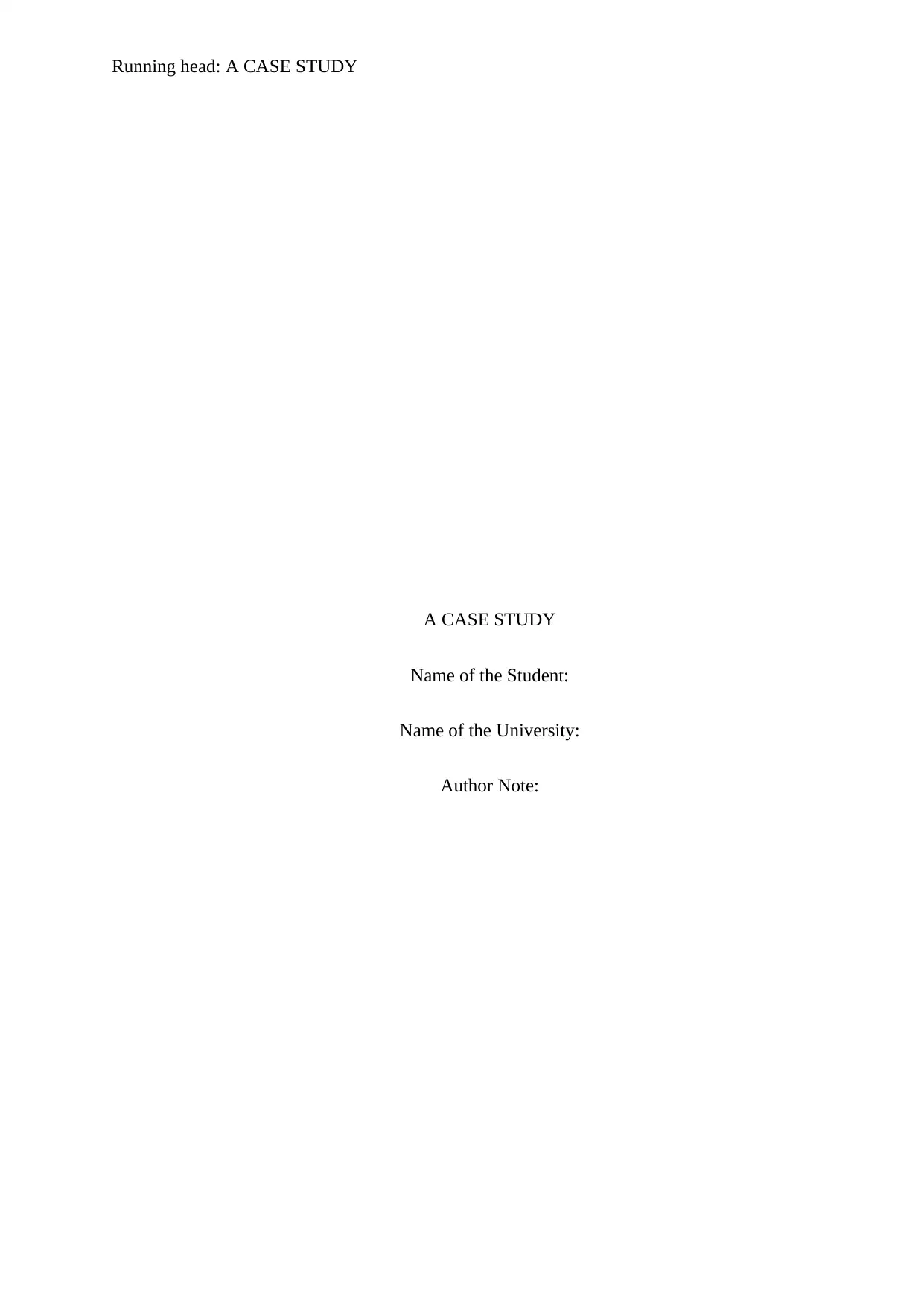
Running head: A CASE STUDY
A CASE STUDY
Name of the Student:
Name of the University:
Author Note:
A CASE STUDY
Name of the Student:
Name of the University:
Author Note:
Paraphrase This Document
Need a fresh take? Get an instant paraphrase of this document with our AI Paraphraser
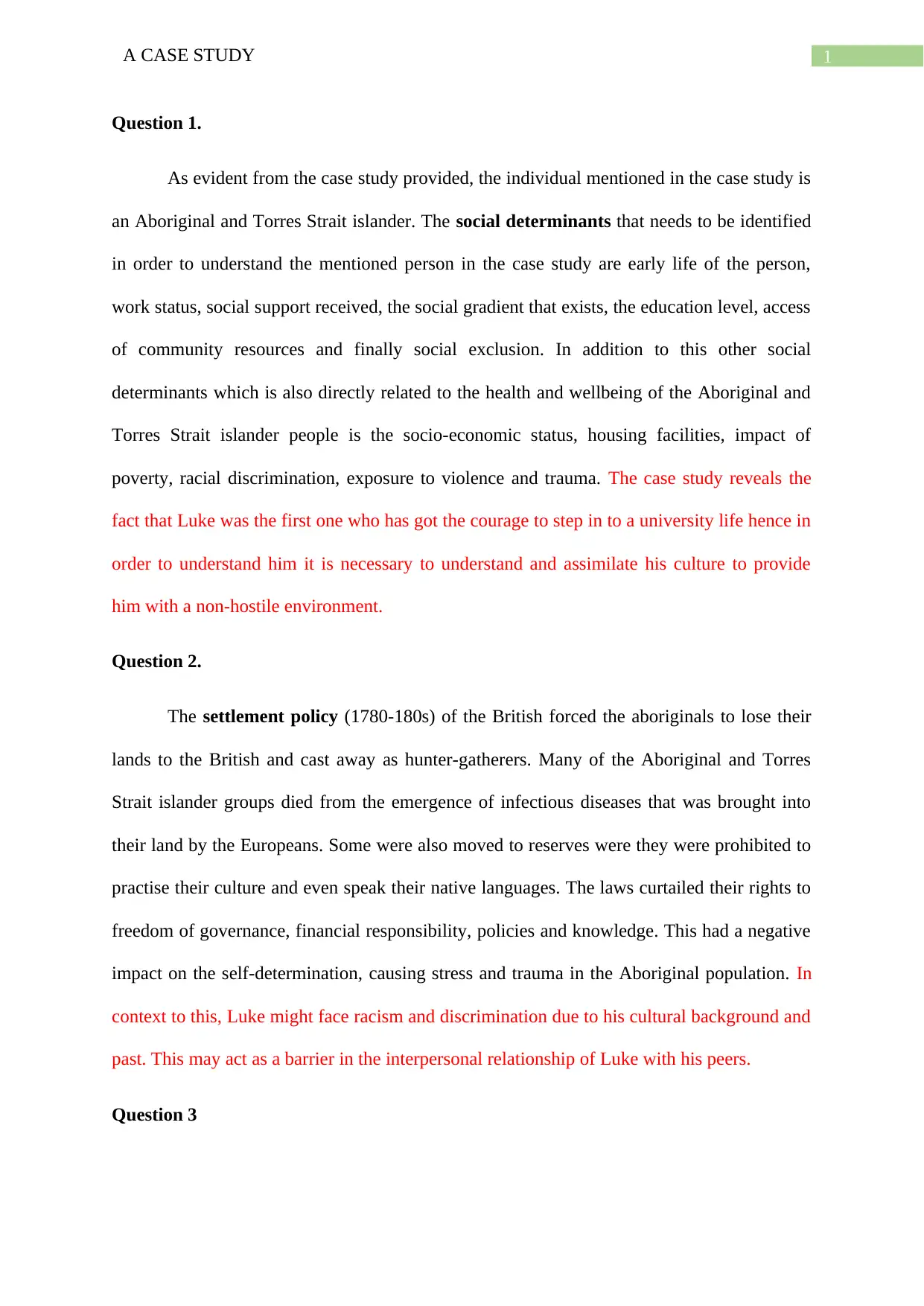
1A CASE STUDY
Question 1.
As evident from the case study provided, the individual mentioned in the case study is
an Aboriginal and Torres Strait islander. The social determinants that needs to be identified
in order to understand the mentioned person in the case study are early life of the person,
work status, social support received, the social gradient that exists, the education level, access
of community resources and finally social exclusion. In addition to this other social
determinants which is also directly related to the health and wellbeing of the Aboriginal and
Torres Strait islander people is the socio-economic status, housing facilities, impact of
poverty, racial discrimination, exposure to violence and trauma. The case study reveals the
fact that Luke was the first one who has got the courage to step in to a university life hence in
order to understand him it is necessary to understand and assimilate his culture to provide
him with a non-hostile environment.
Question 2.
The settlement policy (1780-180s) of the British forced the aboriginals to lose their
lands to the British and cast away as hunter-gatherers. Many of the Aboriginal and Torres
Strait islander groups died from the emergence of infectious diseases that was brought into
their land by the Europeans. Some were also moved to reserves were they were prohibited to
practise their culture and even speak their native languages. The laws curtailed their rights to
freedom of governance, financial responsibility, policies and knowledge. This had a negative
impact on the self-determination, causing stress and trauma in the Aboriginal population. In
context to this, Luke might face racism and discrimination due to his cultural background and
past. This may act as a barrier in the interpersonal relationship of Luke with his peers.
Question 3
Question 1.
As evident from the case study provided, the individual mentioned in the case study is
an Aboriginal and Torres Strait islander. The social determinants that needs to be identified
in order to understand the mentioned person in the case study are early life of the person,
work status, social support received, the social gradient that exists, the education level, access
of community resources and finally social exclusion. In addition to this other social
determinants which is also directly related to the health and wellbeing of the Aboriginal and
Torres Strait islander people is the socio-economic status, housing facilities, impact of
poverty, racial discrimination, exposure to violence and trauma. The case study reveals the
fact that Luke was the first one who has got the courage to step in to a university life hence in
order to understand him it is necessary to understand and assimilate his culture to provide
him with a non-hostile environment.
Question 2.
The settlement policy (1780-180s) of the British forced the aboriginals to lose their
lands to the British and cast away as hunter-gatherers. Many of the Aboriginal and Torres
Strait islander groups died from the emergence of infectious diseases that was brought into
their land by the Europeans. Some were also moved to reserves were they were prohibited to
practise their culture and even speak their native languages. The laws curtailed their rights to
freedom of governance, financial responsibility, policies and knowledge. This had a negative
impact on the self-determination, causing stress and trauma in the Aboriginal population. In
context to this, Luke might face racism and discrimination due to his cultural background and
past. This may act as a barrier in the interpersonal relationship of Luke with his peers.
Question 3
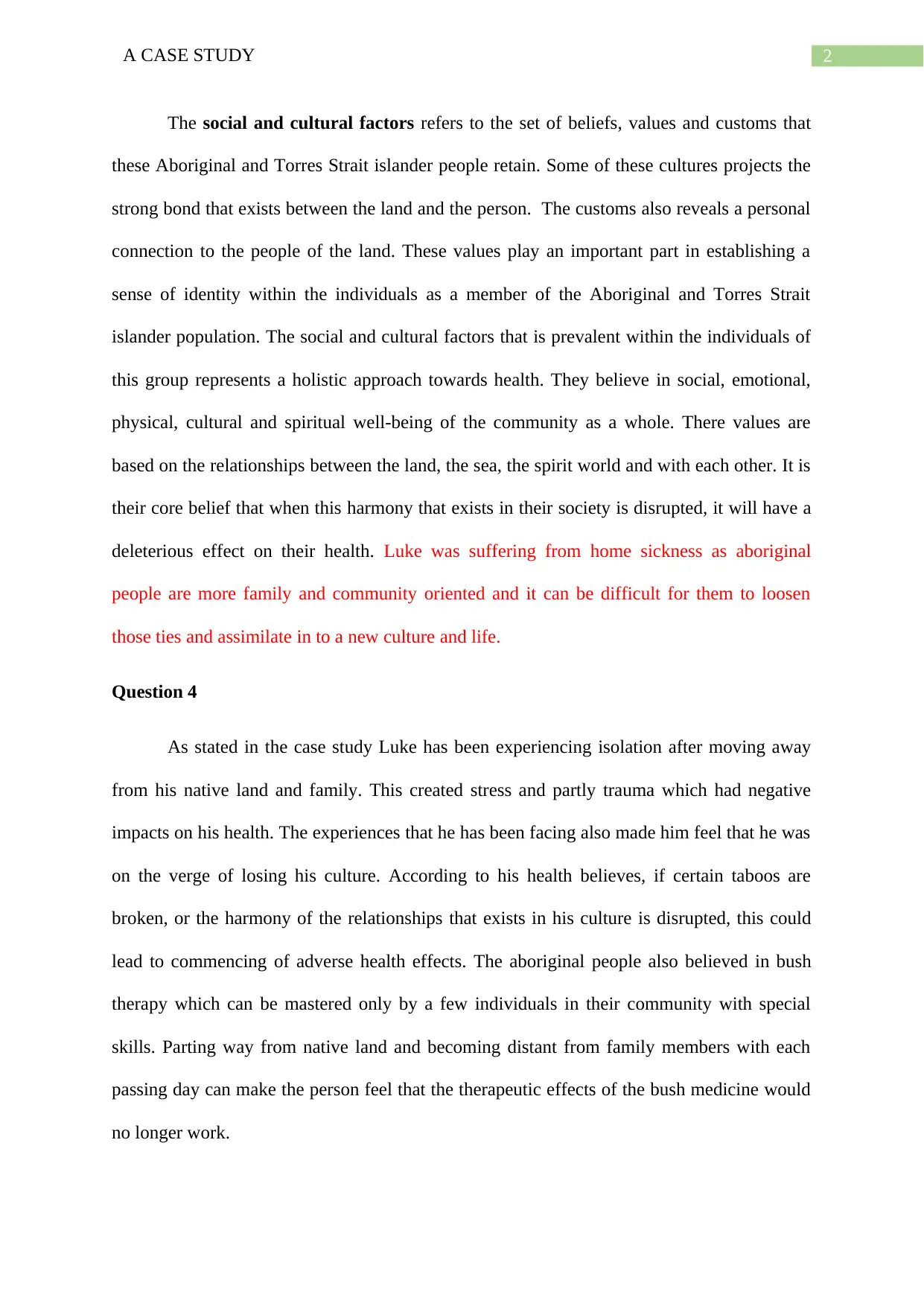
2A CASE STUDY
The social and cultural factors refers to the set of beliefs, values and customs that
these Aboriginal and Torres Strait islander people retain. Some of these cultures projects the
strong bond that exists between the land and the person. The customs also reveals a personal
connection to the people of the land. These values play an important part in establishing a
sense of identity within the individuals as a member of the Aboriginal and Torres Strait
islander population. The social and cultural factors that is prevalent within the individuals of
this group represents a holistic approach towards health. They believe in social, emotional,
physical, cultural and spiritual well-being of the community as a whole. There values are
based on the relationships between the land, the sea, the spirit world and with each other. It is
their core belief that when this harmony that exists in their society is disrupted, it will have a
deleterious effect on their health. Luke was suffering from home sickness as aboriginal
people are more family and community oriented and it can be difficult for them to loosen
those ties and assimilate in to a new culture and life.
Question 4
As stated in the case study Luke has been experiencing isolation after moving away
from his native land and family. This created stress and partly trauma which had negative
impacts on his health. The experiences that he has been facing also made him feel that he was
on the verge of losing his culture. According to his health believes, if certain taboos are
broken, or the harmony of the relationships that exists in his culture is disrupted, this could
lead to commencing of adverse health effects. The aboriginal people also believed in bush
therapy which can be mastered only by a few individuals in their community with special
skills. Parting way from native land and becoming distant from family members with each
passing day can make the person feel that the therapeutic effects of the bush medicine would
no longer work.
The social and cultural factors refers to the set of beliefs, values and customs that
these Aboriginal and Torres Strait islander people retain. Some of these cultures projects the
strong bond that exists between the land and the person. The customs also reveals a personal
connection to the people of the land. These values play an important part in establishing a
sense of identity within the individuals as a member of the Aboriginal and Torres Strait
islander population. The social and cultural factors that is prevalent within the individuals of
this group represents a holistic approach towards health. They believe in social, emotional,
physical, cultural and spiritual well-being of the community as a whole. There values are
based on the relationships between the land, the sea, the spirit world and with each other. It is
their core belief that when this harmony that exists in their society is disrupted, it will have a
deleterious effect on their health. Luke was suffering from home sickness as aboriginal
people are more family and community oriented and it can be difficult for them to loosen
those ties and assimilate in to a new culture and life.
Question 4
As stated in the case study Luke has been experiencing isolation after moving away
from his native land and family. This created stress and partly trauma which had negative
impacts on his health. The experiences that he has been facing also made him feel that he was
on the verge of losing his culture. According to his health believes, if certain taboos are
broken, or the harmony of the relationships that exists in his culture is disrupted, this could
lead to commencing of adverse health effects. The aboriginal people also believed in bush
therapy which can be mastered only by a few individuals in their community with special
skills. Parting way from native land and becoming distant from family members with each
passing day can make the person feel that the therapeutic effects of the bush medicine would
no longer work.
⊘ This is a preview!⊘
Do you want full access?
Subscribe today to unlock all pages.

Trusted by 1+ million students worldwide
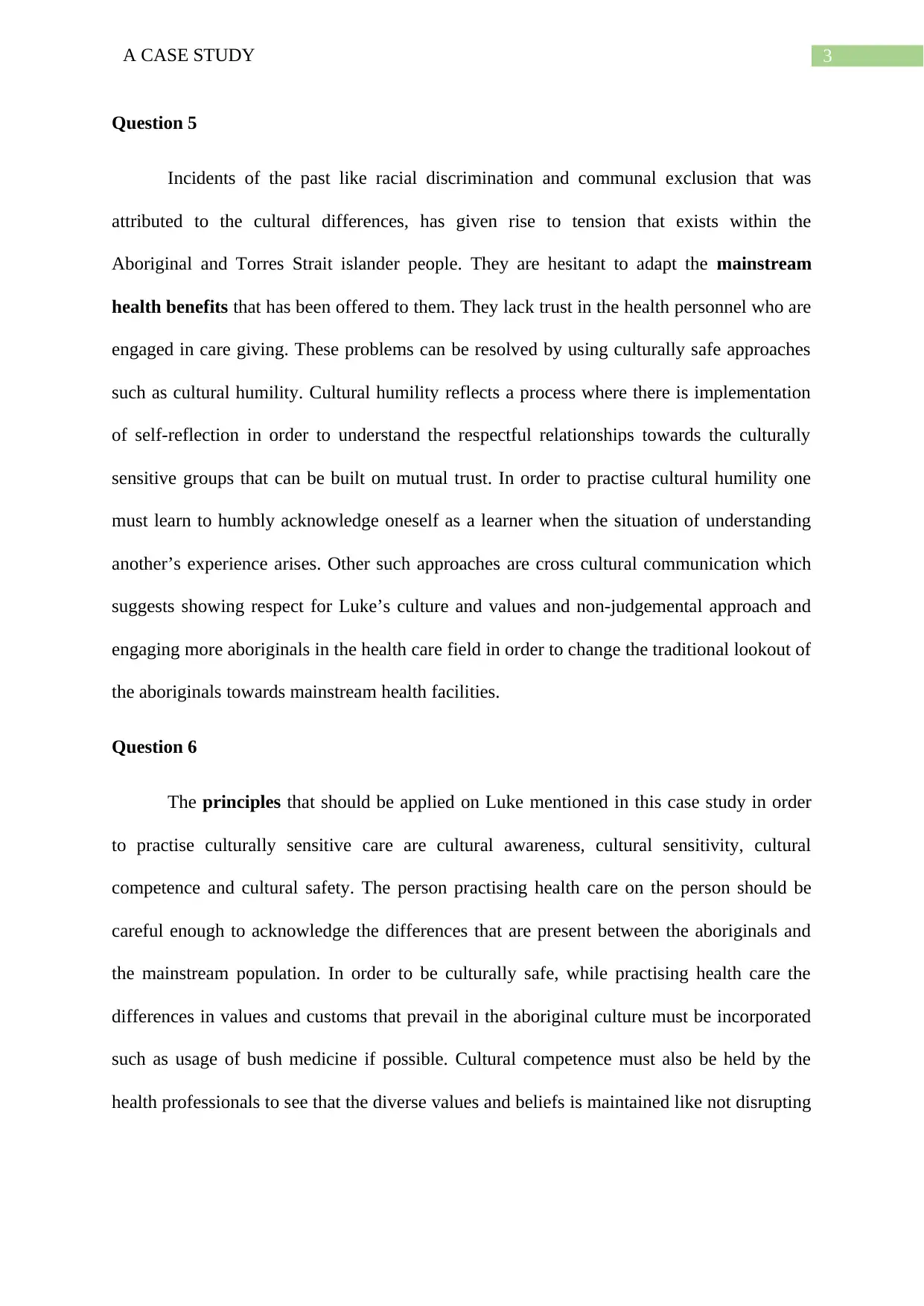
3A CASE STUDY
Question 5
Incidents of the past like racial discrimination and communal exclusion that was
attributed to the cultural differences, has given rise to tension that exists within the
Aboriginal and Torres Strait islander people. They are hesitant to adapt the mainstream
health benefits that has been offered to them. They lack trust in the health personnel who are
engaged in care giving. These problems can be resolved by using culturally safe approaches
such as cultural humility. Cultural humility reflects a process where there is implementation
of self-reflection in order to understand the respectful relationships towards the culturally
sensitive groups that can be built on mutual trust. In order to practise cultural humility one
must learn to humbly acknowledge oneself as a learner when the situation of understanding
another’s experience arises. Other such approaches are cross cultural communication which
suggests showing respect for Luke’s culture and values and non-judgemental approach and
engaging more aboriginals in the health care field in order to change the traditional lookout of
the aboriginals towards mainstream health facilities.
Question 6
The principles that should be applied on Luke mentioned in this case study in order
to practise culturally sensitive care are cultural awareness, cultural sensitivity, cultural
competence and cultural safety. The person practising health care on the person should be
careful enough to acknowledge the differences that are present between the aboriginals and
the mainstream population. In order to be culturally safe, while practising health care the
differences in values and customs that prevail in the aboriginal culture must be incorporated
such as usage of bush medicine if possible. Cultural competence must also be held by the
health professionals to see that the diverse values and beliefs is maintained like not disrupting
Question 5
Incidents of the past like racial discrimination and communal exclusion that was
attributed to the cultural differences, has given rise to tension that exists within the
Aboriginal and Torres Strait islander people. They are hesitant to adapt the mainstream
health benefits that has been offered to them. They lack trust in the health personnel who are
engaged in care giving. These problems can be resolved by using culturally safe approaches
such as cultural humility. Cultural humility reflects a process where there is implementation
of self-reflection in order to understand the respectful relationships towards the culturally
sensitive groups that can be built on mutual trust. In order to practise cultural humility one
must learn to humbly acknowledge oneself as a learner when the situation of understanding
another’s experience arises. Other such approaches are cross cultural communication which
suggests showing respect for Luke’s culture and values and non-judgemental approach and
engaging more aboriginals in the health care field in order to change the traditional lookout of
the aboriginals towards mainstream health facilities.
Question 6
The principles that should be applied on Luke mentioned in this case study in order
to practise culturally sensitive care are cultural awareness, cultural sensitivity, cultural
competence and cultural safety. The person practising health care on the person should be
careful enough to acknowledge the differences that are present between the aboriginals and
the mainstream population. In order to be culturally safe, while practising health care the
differences in values and customs that prevail in the aboriginal culture must be incorporated
such as usage of bush medicine if possible. Cultural competence must also be held by the
health professionals to see that the diverse values and beliefs is maintained like not disrupting
Paraphrase This Document
Need a fresh take? Get an instant paraphrase of this document with our AI Paraphraser
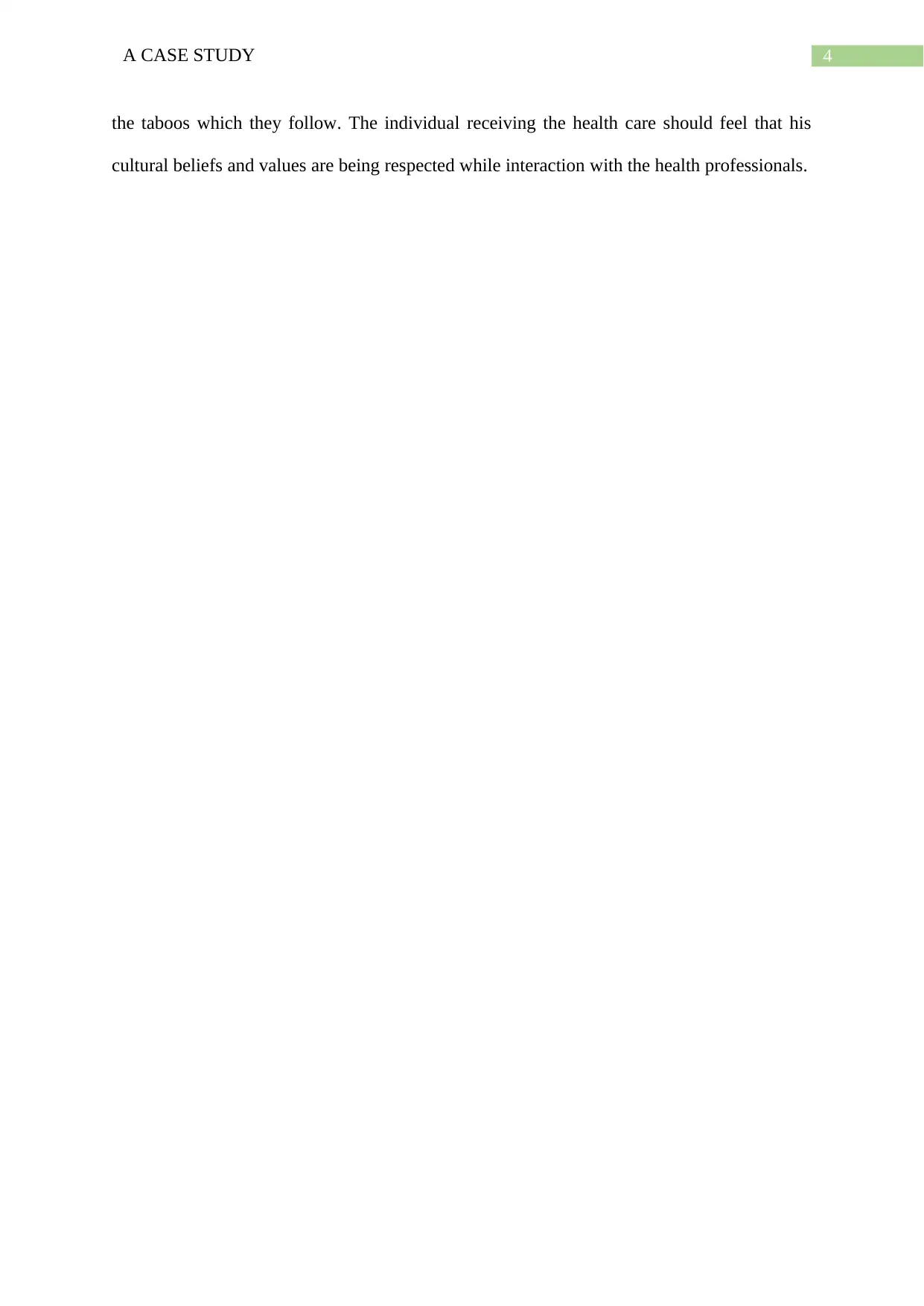
4A CASE STUDY
the taboos which they follow. The individual receiving the health care should feel that his
cultural beliefs and values are being respected while interaction with the health professionals.
the taboos which they follow. The individual receiving the health care should feel that his
cultural beliefs and values are being respected while interaction with the health professionals.
1 out of 5
Related Documents
Your All-in-One AI-Powered Toolkit for Academic Success.
+13062052269
info@desklib.com
Available 24*7 on WhatsApp / Email
![[object Object]](/_next/static/media/star-bottom.7253800d.svg)
Unlock your academic potential
Copyright © 2020–2025 A2Z Services. All Rights Reserved. Developed and managed by ZUCOL.





